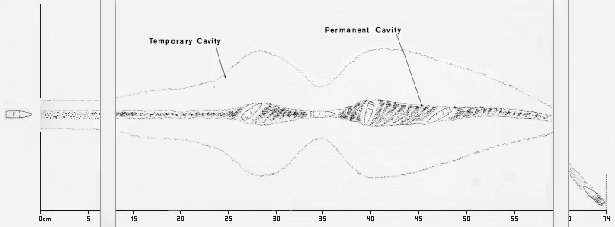
NOTE: This page contains fairly large jpg and gif files so it
will load slowly.
This page continues the wound profiles begun on the first terminal ballistics
page.

This is the wound profile of the 7.62x39 PS Steel Core AK-47 round at 2340 f/s. Great penetration but otherwise not very impressive, eh? The permanent cavity is flat in cross-section. I removed two sections at the left and right sides so the image would fit on the page better. At around 60cm the bullet yawed downward and wound up base first as shown.
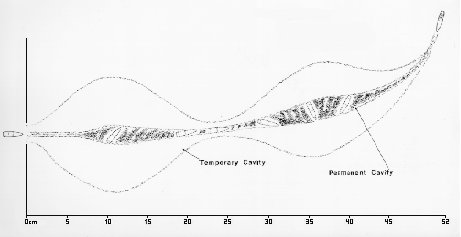
This is the profile of the 5.45mm AK-74 round at 3066 f/s. The lack of fragmentation makes a smaller permanent wound cavity than that achieved by the M16. However, penetration in flesh is better because of no fragmentation. The permanent cavity is actually flat in cross-section due to the long narrow bullet's tumbling so it is not as effective as the M16 rounds.
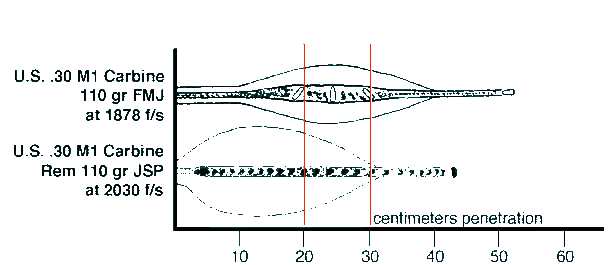
These are 2 profiles of M1 carbine loads. The 110 gr softpoint load makes a wound similar in diameter to a .357 Magnum carbine round with substantially more penetration. The GI ball load makes the typical slit permanent cavity of a tumbling projectile, with the cavity past the typical thickness of a human torso.
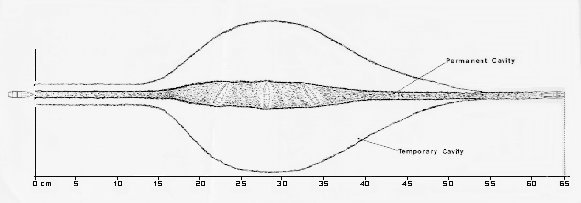
This profile is the M80 7.62mm NATO cartridge, a 149gr FMJ boat tailed bullet at 2730 f/s. This is a classic FMJ military bullet profile for modern non-fragmenting / non-expanding bullets. The bullet ends up base first at a penetration of 25.6". The permanent cavity is flat in cross-section. Note the long neck before the bullet starts to tumble, but in this case at only 2700 f/s and with its heavy jacket the bullet doesn't fragment. Interestingly, if this bullet is driven at 3000 f/s it fragments and behaves just like the M855 5.56mm bullet. Have you noticed the trend for FMJ spitzer flat base/spitzer BT bullets that do not fragment to end up base first?

This profile is of the Winchester .30-30 170gr Silvertip at 2020 f/s. This is typical of medium velocity, expanding rifle bullets.
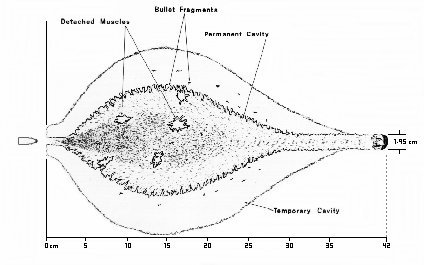
This profile is of the Winchester .30-06 150gr Softpoint at 2923 f/s. Note the larger permanent cavity than the .30-30 but almost identical penetration. Not something you want to get shot with.
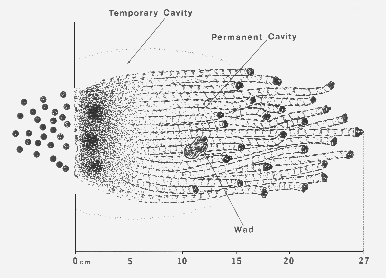
This profile is of the wound created by a 12ga. 27 pellet #4 buck at 1350 f/s. Penetration depth of the deepest single pellet is only 10.6" with the majority between 6" and 10", which corresponds to the known performance of #4 buck--in other word erratic. #1, 00, or 000 buck are a much better choices giving penetrations of about 13", 14" and 15" respectively for standard lead buckshot. While I don't have any profiles available, reports I have received from testers indicate that the use of hardened and/or plated buckshot can provide about a 10-15 percent increase in penetration due to the lack of pellet deformation with the harder pellets.
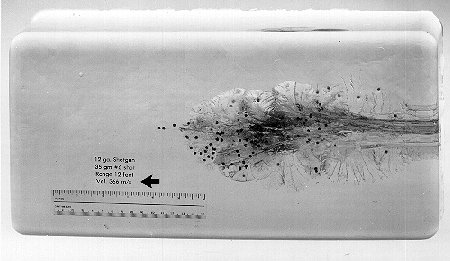
This is an actual photograph of the wound created by a 12 ga load of 1¼ ounces (about 169 pellets)of #4 shot (not buckshot) at 1200 f/s. The maximum penetration is about 11 inches but the majority of the shot is located between about 5½ and 7½ inches. The damage pattern is typical of shotgun wounds at field distances. Number 7½ shot gives about 4 to 51/2 inches of penetration.
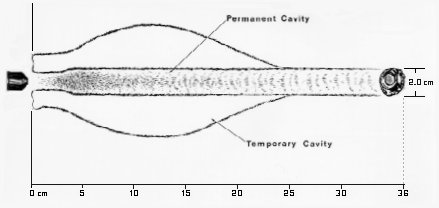
This profile is of the 12ga 1oz (437gr) rifled slug at 1513 f/s. That's about a 1" wound channel and 14" of penetration! Observed penetration for Foster type rifled slugs ranges from 14" to around 18" depending on brand and hardness. No wonder some professional hunters like the 12ga slug as a bear stopper at close range. However, the soft lead slug doesn't fare too well on hard targets. If every bullet made a permanent cavity like this we'd have less discussion on wound trauma incapacitation.
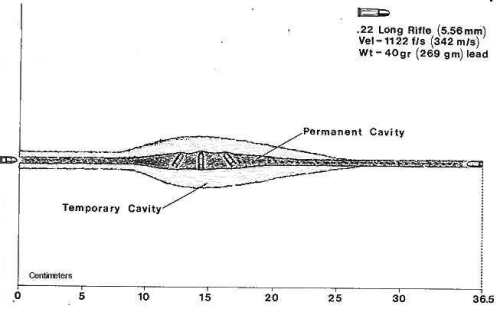 |
The .22 LR round nose lead. Note the typical tumbling of the projectile. If the nose is filed flat it behaves like the HP round below.
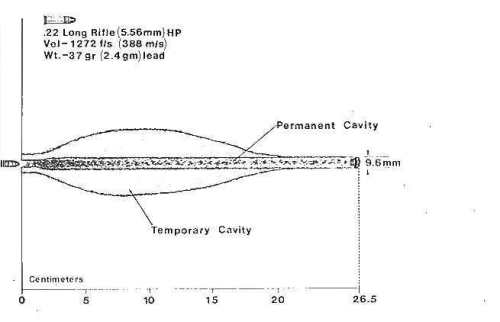 |
.22LR hollow point. Note the straight penetration and permanent cavity
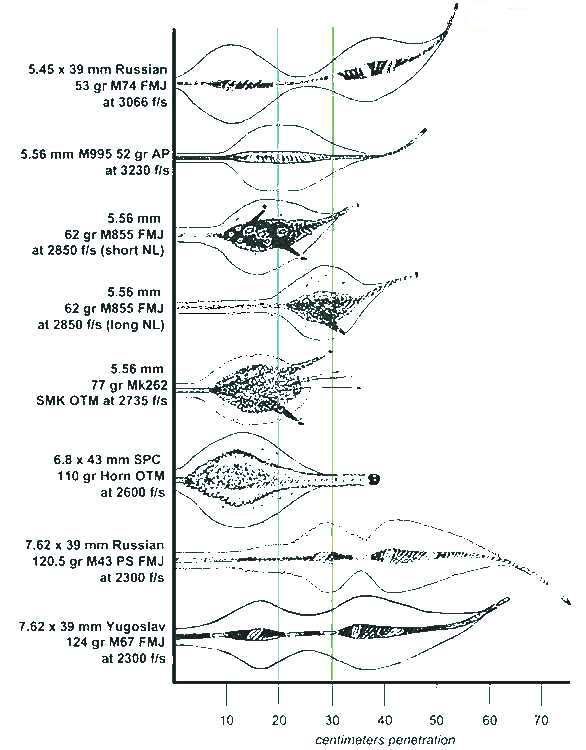 |
|
Assault Rifle cartridges |
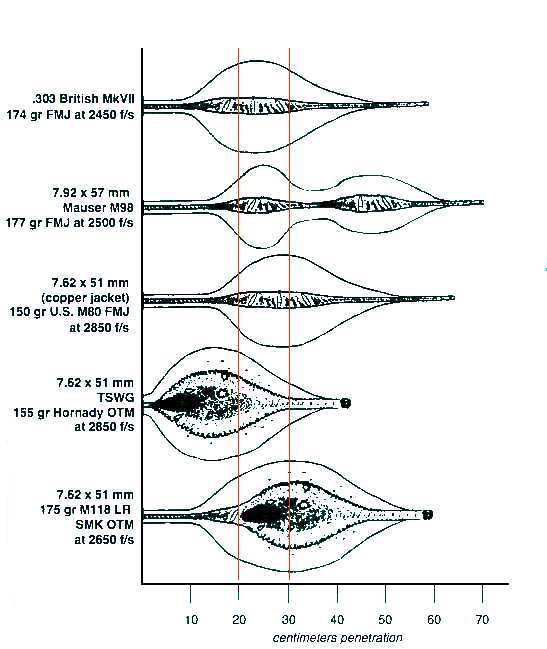 |
|
Battle Rifle Cartridges |
The above The following are some scaled comparisons for common military "assault rifle" and "battle rifle" rounds.
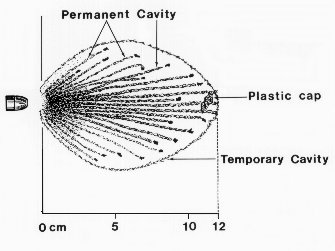
This profile is of the so-called "wonder bullet" the .357 Glasser Safety Slug, 80gr prefragmented bullet at 1785 f/s. This is typical performance of the ultra light weight, high velocity and prefragmented bullets in general . Note the very shallow penetration (4.7"). I'm not impressed, are you?
While the energy dump and temporary cavity schools of thought have been disproved some folks still cling to the temporary cavity theory. Perhaps the real answer lie somewhere between the two. There are many failures of both the high performance/high velocity temporary cavity loads (especially the lighter bullet weight loadings) and also the big bore/big hole loads. While general experience seems to favor the big hole loads, nothing is certain. A lot still depends on the condition of the target. And regarding the comparative virtues of various calibers, using hollowpoint ammo: it is absolutely undeniable that, while a 9mm or .40S&W may or may not expand, a .45 will never shrink.
One famous case of small and fast failure (temporary cavity loads) was widely distributed in law enforcement training circles. A perp (Oops, excuse me--alleged perp.) received an incredible number of 9mm expanding bullets (somewhere around 36--all over his body including the chest and face) yet was not seriously inconvenienced for several minutes. Another similar case was the infamous FBI Dade County shoot out wherein one of the aggressively behaving antisocial misfits was hit solidly with a "high performance" 9mm 115gr JHP. Though the wound would have eventually proved fatal, it failed to penetrate deep enough. He was able to continue fighting and killed several agents with a rifle before being taken out of the fight with a more powerful and destructive load.
As to "big hole" failures, in the People's Republic of NJ there was an incident in the late 60s that shook a lot of folks. A drugged up goblin was shot through the back door and seat of a van he was driving with a 12ga slug. He exited the van with an inch-and-a half hole blown clear through his chest. (Yes, Virginia, daylight was visible!) He ran about 25 yards firing his pistol at his pursuers until he collapsed. (And you thought you were well armed with your 9mm / .357 / 10mm / .45, eh?) Check the wound profiles above for the 12ga slug and compare it with a pistol bullet profile. Then ask yourself if you will ever feel well armed ever again. Under those circumstances a tactical nuke might have been needed to provide the desired WTI..
In the hunting area I'm sure that you have heard of accounts of Cape Buffalo receiving well placed hits of tremendous size and power (500 grains at 2000-2400 f/s) and who yet turned on their antagonist with malice afore thought and lethal intent even though they should have, by all rights, been dead on the spot.
CAVEATS! CAVEATS!
(Some BIG caveats!)
If you carry a short barreled pistol you should test the performance of your ammunition from that short barrel. Most ballistics testing is done with 4" to 5" barreled pistols. Anything shorter than that may not deliver enough velocity for reliable expansion. (Recently Speer has addressed that problem with bullets and ammunition specifically designed for use in short barreled pistols.)
Please keep in mind that all the test procedures and all the calculations of WTI, while they can help us to make informed choices, are simply best guess approximations. In the real world there are simply too many variables and unexpected occurrences to ever be able to predict with 100% certainty what will happen every time a bullet strikes. So...
Always, keep this medical fact in mind!
Bullet hits to the torso that do not cut the central
nervous system cannot be counted upon to cause a
person
(or for that matter a game animal) to immediately cease all actions. Even a total
loss of blood flow to the
brain can still allow 10 seconds of purposeful action--that is more
than enough time to empty a magazine
into you or to stomp you to death.
![Nasty buff (4k jpg]](buff.jpg)
Go ahead. Make my day!
As for me, even though there are no guarantees, I want to stack the deck in my favor as much as possible. I want to reliably cause the most damage possible with every shot. Since bullet expansion can't always be counted on due to intervening material and since Federal, Hornady, Speer, or Winchester don't offer tactical nuclear bullets, I don't like to count on a small bullet hopefully expanding to a bigger diameter. I like to stay with big at the start. Should I ever be lucky to go after dangerous big game I'll use all the gun I can handle. For personal defense I carry a .45 with 200-230 grain expanding bullets of proven design and penetration, but wouldn't feel too under gunned with a stout .40 or a 10 mm ACP.
...and then there is always the Mozambique drill. But that's another topic.
A follow up on the recent rush back to the 9 mm.
The proponents of this step backward claim the the new and improved bullets available for the 9 mm make it the equivalent of the .45. They are forgetting two things. First, is that even the improved bullets often fail to expand or expand fully in live targets (not ballistics gelatin), and second, the improved bullet designs are also available in .45. The also claim that the 9 mm is easier to shoot that a .45. However, the +P loads that are favored have almost as much recoil as most 45s. I have feeling that a lot of people are going to get harmed because of this change over.
ODDS-N-ENDS
FR. FROG'S RULES OF TERMINAL BALLISTICS
1) There ain't no magic bullets!
2) Only center hits count
3) Make the biggest diameter hole you can to let blood out, air in, and destroy as much stuff as you can with each hit
4) Small bullets may expand, but big bullets never shrink.
5) Make the deepest hole you can to ensure that vital organs and nerve centers can be reached and destroyed from all impact angles.
6) "Service" your threat until it is no longer a threat.
7) No small arm can guarantee 100% instant incapacitation of a determined adversary--man or beast.
8) Don't believe manufacturer's claims.
9) Inconsequential increments are meaningless.
10) Most gun writers are pathological liars.
11)"Don't shoot a major caliber man with a minor caliber bullet.
WHAT WE DO SEEM TO KNOW ABOUT WOUND TRAUMA INCAPACITATION (WTI)
There is a big difference between annoying or killing a target and instantly incapacitating them.
The targets mental and physical state play a big part in non-CNS hit incapacitation.
Make the biggest diameter hole you can and make it the deepest you can. - Ideally the bullet will completely transit a body from any angle leaving a big hole and then fall to the ground just outside the exit wound.
"Hydrostatic shock" while measurable, plays no real part in WTI unless inelastic organs (liver, kidneys, brain, etc) are struck. We cannot count on that happening every time.
The only way to always instantly incapacitate some one is to either destroy the central nervous system (We cannot count on that happening every time as the CNS is a very small target.) or to totally destroy the person (requires high explosives and is messy).
Modern bullets are a great improvement in technology but they are not magic.
Small bullets may expand but big bullets will never shrink.
Properly prepared 10% gelatin does not simulate what happens in a live body. It does give us a consistent, reproducible test medium that accurately portrays bullet penetration in unobstructed flesh (no bones) and gives a good approximation of bullet expansion in flesh. If it performs well in gelatin it will PROBABLY work well on a target, given good placement.
Bullet placement is primary.
KE is not a reliable index unless you are talking about piercing armor with a hard projectile.
There are a lot of variables to consider in WTI, and we cannot simulate all of them. {physical and mental state of the target, placement of the hit and bullet path, actual impact velocity, intervening substances, variations in bullet construction, karma, etc., etc}.
WHAT WE DON'T SEEM TO KNOW ABOUT WTI
Just how big a diameter hole is "enough" for all occasions?
How to instantly incapacitate everyone with one shot, no matter where they are hit, using current technology.
What is the "best" round?
How to keep the writers and manufacturers who have an agenda or monetary stake in their products, honest.
WHAT WE REALLY NEED TO DO ABOUT WTI
Cultivate a warrior mindset
Invest in competent, thorough initial training
Maintain skills with ongoing, regular, real world realistic training and practice
Acquire a reliable and durable weapon system
Purchase a consistent, robust performing duty load (that feeds reliably in YOUR weapon and that expands and penetrates well when fired from YOUR barrel length) in sufficient quantities for your use.
STOP worrying about the nuances of handgun ammunition terminal performance.
Credits
Wound profiles courtesy Dr. Martin Fackler and IWBA files
Gelatin photograph courtesy of Letterman Army Institute of Research
To email me click here
| Ballistics Main Page | External Ballistics Page | Zeroing Page | Internal Ballistics Page |
| Rifle Power Page | Misc. Questions |
| Back to Fr. Frog's Home Page |
Disclaimer
As far as I know all the information presented above is correct and I have attempted to ensure that it is. However, I am not responsible for any errors, omissions, or damages resulting from the use or misuse of this information, nor for you doing something stupid with it. (Don't you hate these disclaimers? So do I, but there are people out there who refuse to be responsible for their own actions and who will sue anybody to make a buck.)
Updated 2018-08-09